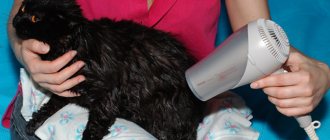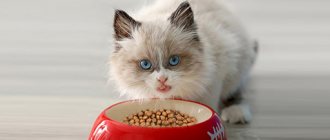How to choose the right wet food
Not all wet food packages are labeled as complete food. If there is no such mark, it means that the product was not balanced with all the necessary nutrients, which can also be noticed by the absence of a vitamin-mineral premix in the composition.
Most often, such products consist of one type of meat or fish, as well as a mixture of them in different proportions. This does not mean that the product is bad, it just cannot be fed to it constantly, but only treated to the cat periodically, in addition to the main diet.
Does moist mean it's healthier?
Many owners believe that wet food is healthier than dry food or vice versa, but this is not true - each of these types of food has its own disadvantages and advantages. With complete wet foods, the latter are quite obvious.
On the one hand, cats certainly like such foods more; in addition, they contain a lot of moisture, and consuming enough liquid is critically important for cats. There is another positive point: such food does not require the addition of preservatives, because in sealed packaging the product does not spoil for a very long time.
True, this is a conditional advantage; high-quality dry food uses tocopherol-based preservatives, which do not have any harmful effects on the cat’s body. But there are still exceptions!
Well, the main disadvantage of wet food is the price; feeding them only will cost the owner much more.
Benefits and harms
So is it still possible to pamper your furry pet with fish dishes or is it not worth the risk? To understand this issue, you should familiarize yourself with the beneficial and harmful properties of fish.
Among the main beneficial properties of the product are:
- presence of easily digestible protein;
- a large percentage of vitamins A and B;
- contains a significant amount of phosphorus and magnesium;
- Fatty fish products can be a source of omega-3 fatty acid.
However, such products have much more harmful qualities. Below are just the main ones.
- Damage to the kidneys. A large percentage of salt contained in products negatively affects the functioning of this organ. Often, pets who eat fish suffer from urolithiasis, since the presence of phosphorus and magnesium in the composition contributes to the formation of struvite (urinary stones).
- Increased risk of developing helminthic infestation. Against the background of helminthiasis, damage to the liver, gallbladder and pancreas occurs. Most often, helminthiasis is caused by an animal’s improper diet. Under no circumstances should you feed your pet raw fish that was caught in the river.
- The development of hypovitaminosis, which develops against the background of the presence in most varieties of fish, of the enzyme thiaminase, which destroys B vitamins. As a result of this, the cat begins to suffer from anemia.
- A decrease in the content of vitamin E in the body, which occurs against the background of the systematic inclusion of fish in the pet’s diet.
- A large number of bones, which often causes injury to the animal’s larynx and esophagus.
- Why can't cats fish? One of the reasons is the content of destructive thiaminase in some fish species. Thiaminase promotes the release of B vitamins. To destroy the dangerous substance, boil the fish in boiling water for at least 10 minutes.
Not every type of fish can be given to an animal
Feed your cat the usual wet food and little by little
When feeding wet diets, you should avoid variety; it is better to choose one type of food that suits your cat and stick with it. Constantly changing your pet’s diet is neither necessary nor beneficial.
Unlike dry food, wet food cannot be left in a bowl, so the feeding pattern will be fundamentally different. The daily intake should be determined according to the instructions on the product packaging and adjusted depending on the condition of the animal. To prevent overeating, get into the habit of weighing your cat regularly.
The daily norm should be divided into several feedings and given often, but little by little. We immediately put the uneaten portion in the refrigerator, and then be sure to warm it up to room temperature in the microwave.
The contents of an open package can be stored in the refrigerator for no more than a day in a tightly closed container, for which the edges of the bag are tightly wrapped and secured with a paper clip, and the contents of the jar are transferred to a glass or plastic container with a lid. It is very important to wash the bowl after each feeding because even microscopic remains of wet food become a breeding ground for bacteria.
If you do not have the opportunity or time to feed your cat wet food correctly, taking into account all of the above, it is better to abandon this idea in favor of high-quality dry food.
And one more thing: despite the fact that canned diets contain a lot of moisture, feeding wet food does not negate strict control over the cat’s water intake.
Is it possible to feed a cat canned fish?
Is it possible to feed a cat canned fish ? Some cat owners may say that they feed their cat canned food all his life, and nothing. Maybe nothing for now, but this diet clearly backfired on our cat.
Our Kesha is generally a gourmet, and will not eat just anything. Most of all he loves sprat in tomato and sour cream. He may even dance for these treats. Out of false pity, we tried to give Kesha his favorite sprat more often. If we knew how it would end, we would never have done this.
One fine day, Kesha refused to eat. That was incredible. At first we thought he was just overeating because the day before we had fed all our cats a ton of scraps of meat. But no one refused to eat after that.
On the second day, Kesha even stopped drinking. This already alarmed us, but it was reassuring that there was no blood in his urine.
On the third day I took him to the vet. They examined and touched him for a long time, but nothing dangerous was found. Just in case, he was injected with vitamins and sent home.
Two days later, we began to inject glucose and saline into his withers to prevent dehydration. We went to the system for another week. Veterinarians diagnosed him with urolithiasis. But I didn’t believe it, because... With this disease, cats cannot urinate, and Kesha blew at least half a liter several times a day.
After a couple of days, he suddenly turned all orange, although he already had a red color. It became clear even to me that his illness was related to the liver. We didn't stop stabbing him. What was prescribed was what they injected. But a week later, the veterinarians said that his liver had already completely decomposed, and there was no point in further treatment.
And then my mother ended up in the hospital with a broken arm, and my daughter and I decided not to torture the cat and let him die peacefully. Kesha no longer had the strength, but he still went to the toilet. We didn't do anything with it for a week and a half. Only in the morning and evening I wiped Kesha with a wet cloth and tried to at least give her something to drink. But it was all in vain. The cat slowly faded away.
Every morning I approached him with fear and stroked his head. There was only one skin left from the cat. The smell emanated from him was such that flies flocked to him. But the cat didn’t want to die.
The dog developed otitis (ear disease), and I called the veterinarian to the house. She was very surprised that the cat was still alive and suggested that he be euthanized. I flatly refused.
A couple of days later, my mother was discharged from the hospital, and when she saw that Kesha was still alive, she told me to immediately take time off from work, go to the pharmacy, buy new solutions of glucose and saline, and run home. I did so, although I understood that nothing would help Kesha. He had been without water for too long.
And yet I wanted to believe in a miracle. My mother couldn’t help me hold the cat, so I asked my daughter. Oddly enough, he still had strength. I was very nervous. I felt sorry for the cat. The skin on the withers has become hard. I could barely pierce it. Somehow we were able to inject him with a couple of 20 gram syringes of solutions.
And suddenly the cat screamed in a wild voice, jumped up, ran, staggering several meters, fell and froze with glassy eyes. All three of us stood over him and roared in one voice. It was clear that he was killed.
And a few minutes later it dawned on me that I had incorrectly calculated the dose of medication and infused it twice as much as normal. The cat was not breathing, and we went into another room to decide what to do next.
And suddenly, in the ringing silence (even our other cats and dog fell silent and did not show themselves) we heard the sounds of lapping water. I carefully went into the kitchen and almost fell in surprise.
Kesha stood over a jar of water and quickly lapped up the water. It was something incredible. He drank almost half a liter. Then he turned around and staggered towards the food bowl. I barely managed to hide it. After such a hunger strike, food can only be given in crumbs, otherwise the cat will die.
For two days we fed Kesha hourly and little by little. He screamed and kept asking for food. We could barely hold back our tears, but we stuck to the diet. From lying for a long time, open wounds-bedsores formed on his paws. I had to treat them with levomekol.
A week later, Kesha became normal in color and was slowly gaining weight. A week later, I took the cat to the veterinarians for examination. They couldn't believe he survived. They even thought that I had found the same cat and brought it to them.
We no longer give him sprat in tomato, and we don’t buy canned food at all. It’s good that we only fed him with these canned foods, otherwise all our cats could have gotten sick, and even then such healing would not have happened, because Kesha is the strongest cat we have. And he had a real non-infectious hepatitis. Apparently the tomato sauce with spices disrupted the liver.
This is how we realized that such food for cats is very dangerous. And now, no matter how much we want to pamper our pets, we have to think about the consequences. Now we know how many times a day and what to feed the cat, and whether it is possible to give it dog food.
Take care of your pets!
Is it possible to combine canned food with other types of food?
It is possible if you follow feeding standards. When canned food and dry food are produced by the same manufacturer, you can find the appropriate instructions on the packaging. For example, in the table opposite the cat’s weight it may be written like this: 30 g of dry food + 1 ½ bags of wet food. This is the daily norm for a mixed diet.
If the manufacturers are different, then you need to experiment yourself. As a starting point, take half the daily intake of dry food and half of wet food (in accordance with the general recommendations on the package). Then monitor the animal’s condition and adjust the norm if it loses or, conversely, gains weight.
The biggest mistake that owners make when buying wet food for their cats is that they don’t consider it food, but tend to classify it as something like a dessert that they can treat their cat to. Nevertheless, this is food, and it must fit into the cat’s daily diet. Otherwise, overeating cannot be avoided, and with it all the accompanying problems.
What kind of canned food attracts cats?
To arouse the interest of pets, canned food must have a pronounced fish or meat aroma . These aromas that cats prefer in food will be felt brighter in canned food, since in addition to natural ingredients, manufacturers can add artificial additives and flavor enhancers.
Cats have a very keen sense of smell, so it is not difficult for them to determine the freshness of food from afar. The animal will not approach stale canned food.
How to give canned food correctly?
Naturally, the dose of treats given should be small. Canned food can be given to healthy cats whose diet consists of natural products: porridge, soups, meat, fish, eggs.
You should not combine regular canned food with cat food to avoid intestinal dysfunction. If an animal consumes exclusively specialized food, a sudden change in its diet by introducing unfamiliar products will have a detrimental effect on its body.
Since ordinary canned food may contain substances that irritate the delicate lining of the intestines, they should be given mixed with other foods, thus, the negative effects after eating them can be somewhat reduced.
It is very important to remember that a mono-diet of canned food alone can harm even the healthiest animal.
It is preferable to feed canned food containing lean varieties of fish or meat - such a product will be easier for the cat to digest. Canned saury or pork can have a negative effect on the liver, because this organ of cats is very sensitive to large amounts of fat.
Canned food should not be given together with fermented milk products, such as fermented baked milk or cottage cheese, as the protein contained in them will conflict with fermented milk bacteria.
To give or not to give?
But if the animal is healthy and has a great desire to eat canned food, you can give it to the animal in small quantities, but not on a regular basis . Anyone, even the healthiest animal, can begin to fail if the cat is fed canned food constantly, in large quantities.
If the cat is completely healthy, you can add a small amount of canned meat or fish to its usual natural diet, you can significantly please the animal, which will lead to a decrease in aggression and anxiety.
How to properly give fish to cats, feeding frequency
You can add fish to your cat’s menu no more than 1-2 times a week, as it is addictive. Fish should be given to the cat boiled - after a little heat treatment, the protein will be better absorbed by the body. In addition, high temperature kills parasites and their eggs, which are often found in the insides of fresh fish.
Some feeding tips:
- Boiled fish should be without scales, bones and entrails;
- Cook fish without salt and spices;
- Fillets of sea and ocean fish must first be frozen;
- Give preference to low-fat fish: salmon, cod, halibut, hake;
- It is advisable to serve fish in combination with vegetables, seaweed or cereals;
- Stale food is not acceptable.
The quality and freshness of the fish should come first when choosing a product for your pet. Fresh produce will emit a pleasant aroma; the gills should be light. By pressing the fillet with your finger, it will retain its shape and will not fall off the sides.
Young cats can be periodically pampered with fatty fish, but mature cats are better fed exclusively with dietary varieties. During pregnancy, you should not feed your cat fish. Castrated and sterilized cats are fed fish no more than 2 times a month.
During the cold months, you should add fish oil to your pet's food, which contains vitamins A and D. It is better to exclude red fish from your pet's menu, as it has a negative effect on digestion.
If owners feed their cats factory-made food, then there is no need to add fish to the menu. This can lead to digestive system disorders. It is important to note that when preparing ready-made feed with the addition of fishmeal, the daily consumption rate is taken into account, so problems for the animal’s body are eliminated.
To give or not to give?
there is no direct need to feed them to domestic cats . In addition, for cats with a very sensitive digestive system, eating canned food can lead to disruption of the body's excretory functions. But if the animal is healthy and has a great desire to eat canned food, you can give it to the animal in small quantities, but not on a regular basis . Anyone, even the healthiest animal, can begin to fail if the cat is fed canned food constantly, in large quantities.
If the cat is completely healthy, you can add a small amount of canned meat or fish to its usual natural diet, you can significantly please the animal, which will lead to a decrease in aggression and anxiety.
Risk of contamination of feed with toxins or microorganisms.
What is written in this paragraph applies to both cheap dry food and cheap canned food. Considering that cheap pet food manufacturers use pesticide-laced grains and sick, dead and dying animals to produce their products, it is not surprising that this results in ingredients that are often heavily contaminated with a wide range of toxic substances. Some of them are destroyed by processing, while others are not.
- Bacteria and bacterial toxins. Animals that have died due to illness, injury or natural causes are often sources of raw materials for economy-grade pet food. Products commonly found in budget dry pet food include chicken meal, poultry meal, and meat and bone meal. Animals that die on a farm are sometimes not sent to the facility for several days after death. As a result, these carcasses can be highly contaminated with bacteria such as Salmonella and E. Coli. While the cooking process kills bacteria, it does not eliminate the toxins that some bacteria produce when they multiply. These toxins often survive processing and can cause illness and disease in your cat. Most manufacturers of economy class food do not test their products for the presence of bacterial toxins, as this will lead to higher prices for products compared to competitors.
- Medicines. Since sick animals were likely given various drugs to treat their illness or to be euthanized, their meat is likely to contain these substances after death. Penicillin and pentobarbital (a drug used for euthanasia) are just two examples. Some euthanasia drugs or antibiotics can safely survive the processing that meat undergoes and enter your purr's body.
- Mycotoxins. Toxins from mold or fungi are called mycotoxins. Modern agricultural practices, adverse weather conditions and improper drying and storage of crops contribute to the growth of molds. Unfortunately, in recent years there have been an increasing number of incidents involving the illness and death of pets due to this toxin. In particular, in the USA, several years ago, in just a month, more than 100 dogs were killed by mycotoxin after eating contaminated dry food.
- Chemicals. Pesticides, herbicides and fertilizers can leave residues on plant foods. Grains treated with these chemicals, which are prohibited for human consumption, can be legally used in pet food.
Is it possible to feed a kitten fish?
Veterinarians suggest that twice a month you can feed your kitten boiled fillets of sea fish, such as pike perch, flounder and cod. Fish should be lean and boneless.
Fish contains many fatty acids and microelements that are beneficial for a kitten, but frequent consumption can harm its health, as it interferes with the full absorption of vitamins B and K, which upsets the balance of phosphorus and calcium in the animal’s body.
Fish is good for a growing kitten, and a toy in the shape of a fish will cheer you up











